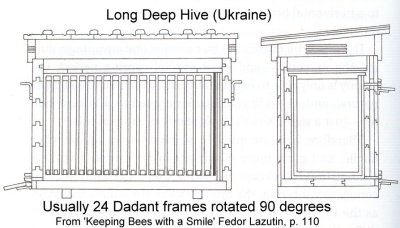
Modified Einraumbeute See also new book: The Modified Golden Hive (Einraumbeute) here
The Einraumbeute (ERB) is a single-chamber trough hive developed by Mellifera e.V., Fischermühle, Germany. Its frames are Dadant size only rotated through ninety degrees. It is sometimes called the 'golden hive' because its frame and shape is based on the golden section/ratio/mean/proportion. Mellifera's page on the ERB, including links to PDFs of plans is here.
In their book Imkern mit der Einraumbeute (Pala Verlag, 2020), Johannes Wirz and Norbert Poeplau present the advantages of the Einraumbeute:
This book was published in English in 2021 by the International Bee Research Association and Northern Bee Books under the title 'Keeping bees simply and respectfully -- Apiculture with the Golden Hive', ISBN 978-1-913811-03-7 )
The hive has a Ukrainian precursor which also uses Dadant frames rotated through ninety degrees. According to Fedor Lazutin1 this hive usually has 24 frames. He gives the size of these frames as 285mm wide by 460mm deep (p. 102) or 300mm wide by 435mm deep (p. 111). The former is very close to that of the Bodenschatz Einraumbeute size (285mm x 458mm).

I'd been considering making an Einraumbeute for some time, but was put off by the high shipping costs for importing the frames from Germany. However, in 2014, Matt Somerville announced that he was producing the frames and the hive, albeit modified, for sale.2 Accordingly I bought a set of 22 and made my modified ERB in the winter of 2014-2015.
The frames and the inner trough essentially follow Mellifera's dimensions. The main departures from Mellifera's design are:
1. Double walls with insulation in between (inspired by Fedor Lazutin's trough hive)
2. Warré hive top-bar cloth, quilt and roof configuration
3. Entrance at one end through a notch in the floor (similar to Warré hive floor)
4. No mesh floor or Varroa tray, but solid floor that slides out
5. Provision for emergency ventilation in front, rear and floor.
No plans are available for this modified ERB as it was largely tailored to scrap wood available from a plant crushing domestic waste wood (furniture etc.) for an electricity power station. The following photos illustrate the construction:
Below left: inner trough in 20 mm
pine with cavity wall frame top and bottom. Internal length 830 mm, i.e. slightly more
than Mellifera's, allowing room for 22 frames and a follower/division board.
Below right: roof infrastructure adapted from the Warré
roof. The ridge board is for use if thin gauge aluminium (e.g. caravan cladding) is used.
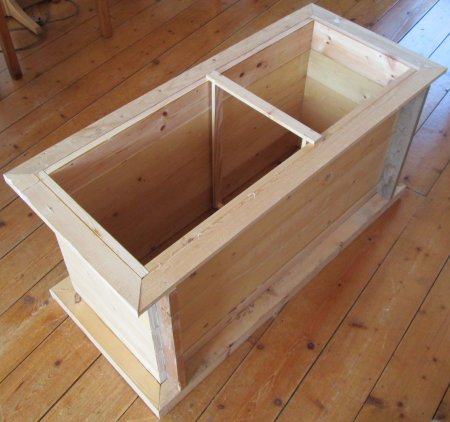
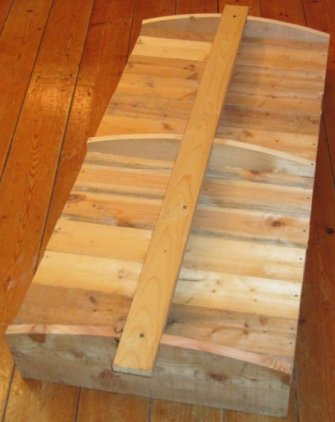
Below: method for inserting Phragmites australis reed insulation and cladding with 20 mm pine.
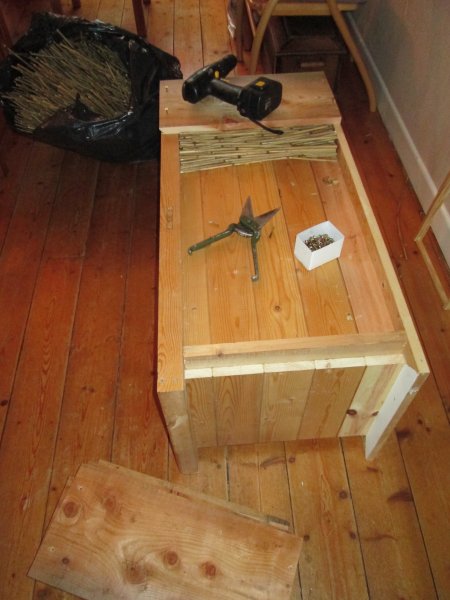
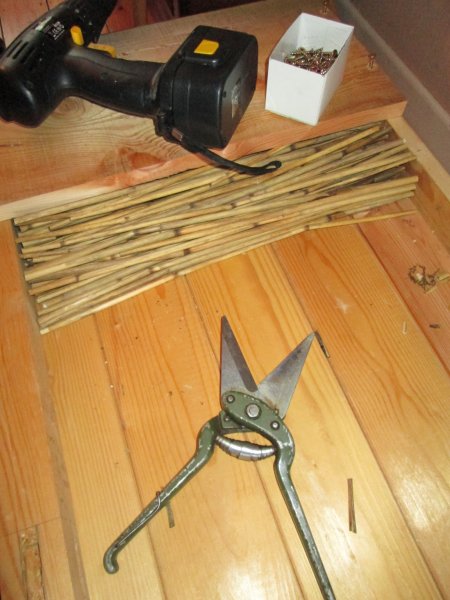
Below left: emergency vents,
closed with corks when not used. Below right:
removable floor pulled out
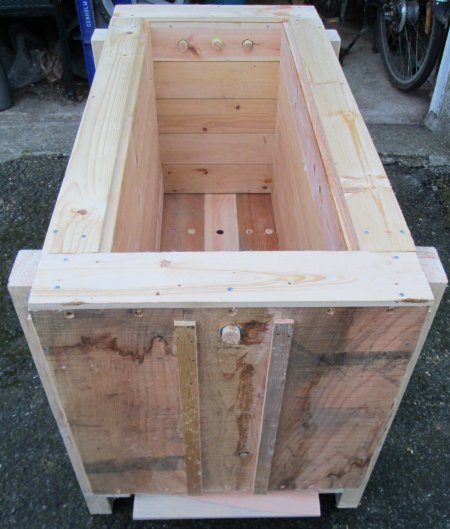
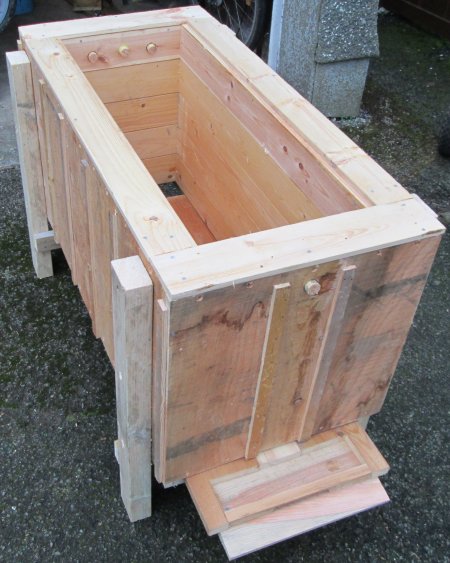
Resting on rails, the floor slides out for cleaning. There is a 3 mm clearance between it and the bottom rim of the inner trough. When in use, that gap is closed with a wedge in each corner, between the rails and the underside of the floor.
Below left: full width entrance,
alighting board and entrance restrictor. Below
right: entrance detail, floor pulled out
Entrance sizes 60 cm2 or 18 cm2.
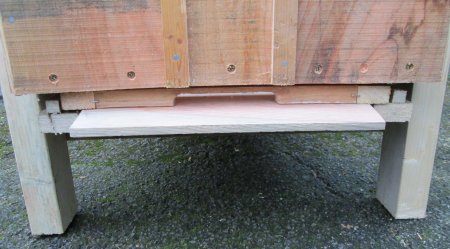
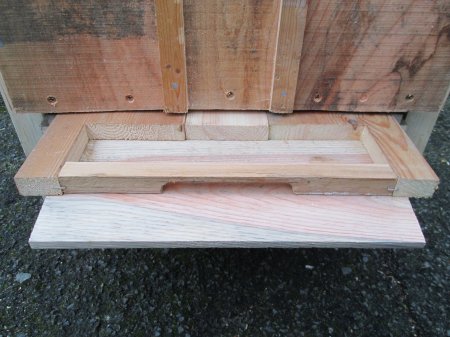
Below left: double Warré-type quilts filled with planer shavings Below right: modified Einraumbeute complete.
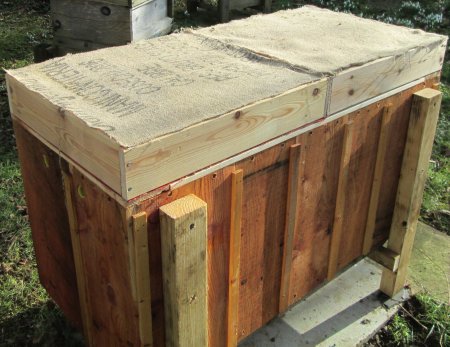
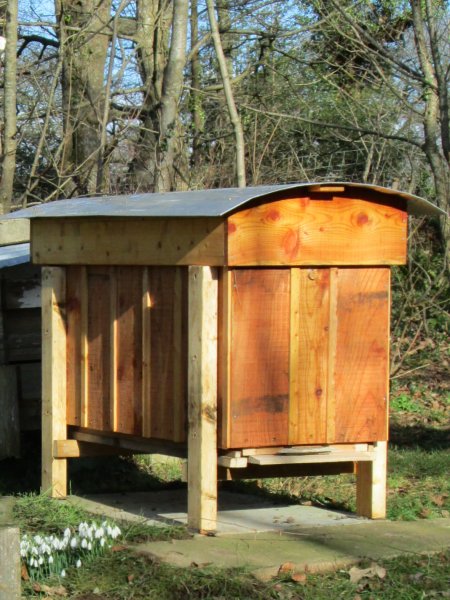
Below left: ERB frame with spacers and comb supports Below right: ERB frame superimposed on a 'Lazutin' frame
Below: Top-bar cloth of hessian (jute sacking) sized with rye flour and maize starch paste.3
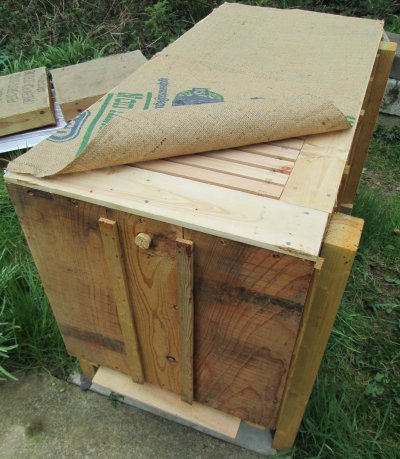
The sack contained bird food peanuts and was obtained from a pet shop.
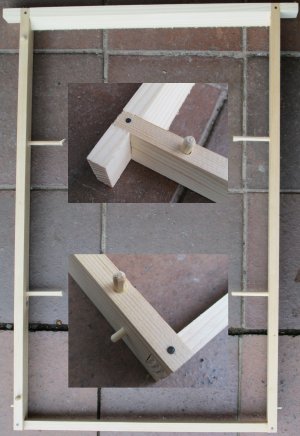
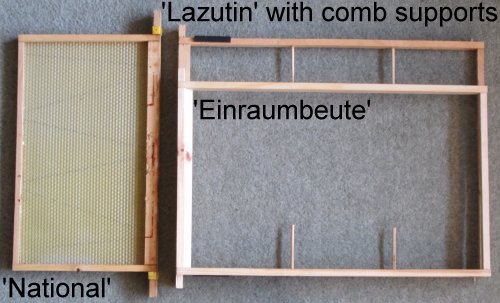
Frame measurements (mm):
Somerville (this project): top-bar 325 x 20 (lug 10); side-bar 463 x 10; bottom-bar 285 x
10; midrib 265 x 430; width top/sides 27
Bodenschatz (Mellifera): top-bar 327 x 20 (lug 10); side-bar 458 x 10; bottom-bar 285 x
10; midrib 258 x 422; width top/sides 28
Frame spacers and comb supports
The comb spacing is 35 mm. As the frame width is 27 mm the frame-to-frame 6 mm bamboo
skewer spacers have 8 mm projections. There are two on each side bar, one at the top and
one at the bottom. The pair on one side bar faces in the opposite direction to the pair on
the other. This allows frame reversal should it ever be necessary. The frame-to-wall 3 mm
bamboo skewer spacers project 6 mm from the frame side bar. The 6 mm bamboo comb supports
project 40 mm from the side bars.
Top-bar wax starter strips
As there have been some reports with cross combs in the ERB, the
precaution was taken of depositing wax starter strips on the bottoms of the 'V' profile of
the top-bars. These strips were made bold, up to 10 mm deep, to give a clear signal to the
comb builders. The method was to pour wax against a wetted template held against the
top-bar. The template comprised a piece of top-bar positioned such that the starter strip
would hang vertically. The template merely rested against the frame top-bar with the help
of two frame pins inserted at the edge of the bevel (see photo below).
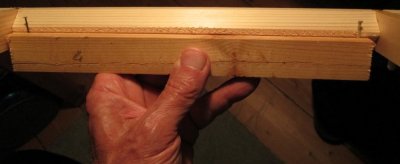
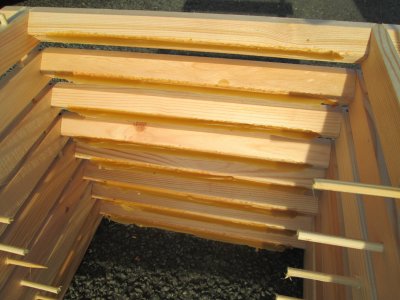 Top-bars with wax
starter strips
Top-bars with wax
starter strips
23 June 2015 -- Populating
Eight frames with starter strips were placed at the entrance end. A division board closed off the unused part of the hive. This was adapted from the follower board by putting a foam plastic round the bee spaces. A swarm of about 1.5-2 kg was run in.
Below: left -- division board; centre -- running in a swarm; right -- swarm settled in
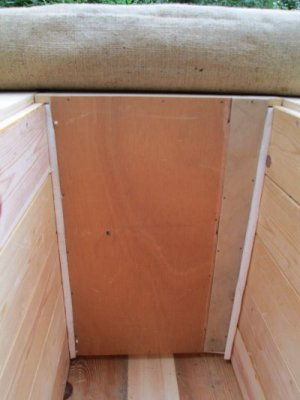
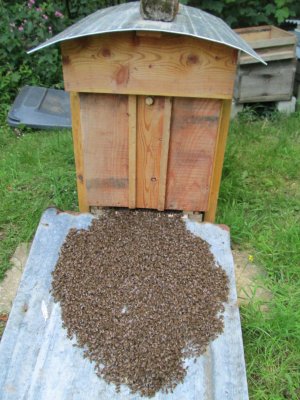
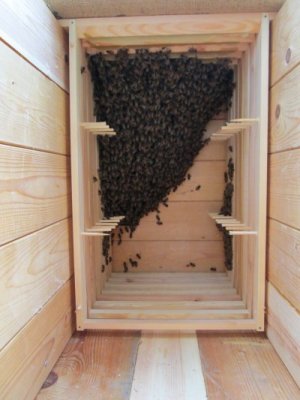
To minimise absconding due to the new wood in the hive a queen includer was placed over the entrance for 24 hours. As the swarm came to a bait hive only 1.6 km away, in order to force reorientation, leafy branches were placed in front of the entrance.
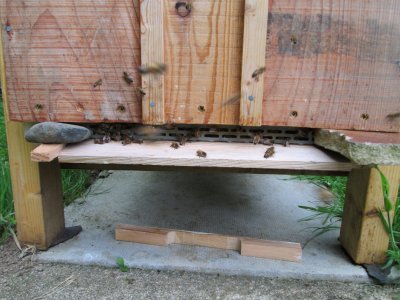
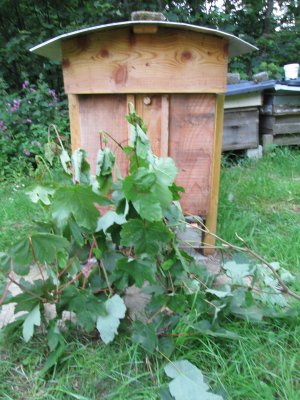
Below: early orientation:
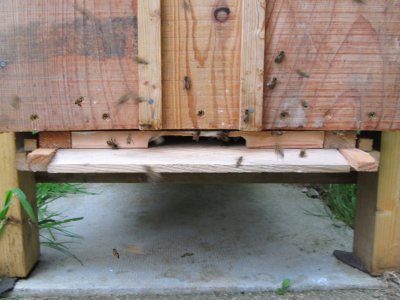
3 July 2015
Comb was already built on 7 of the 8 bars, but the only brood was a tight patch the size of a hand on both sides of frame 1 near the entrance. The eggs were off centre and did not look a normal shape. A few cells had raised edges and one or two had drone-size larvae in.
8 July 2015
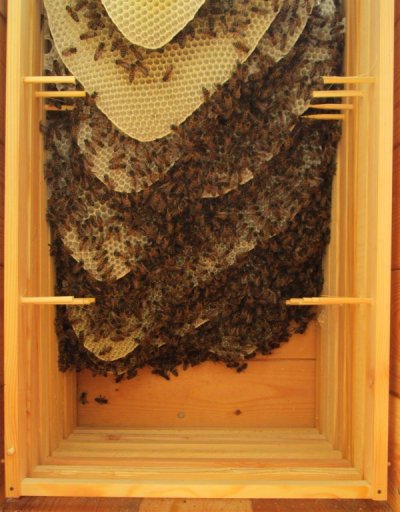
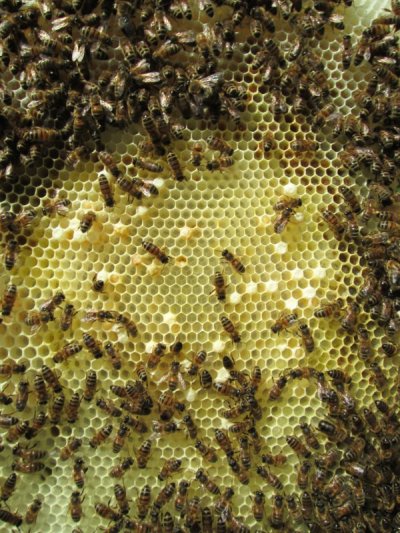
A good quantity of comb had been built by 8 July and honey and pollen stored in it, but the low amount of pollen seen coming in on several visits did not suggest a productive colony. Most of the cells in the brood patch on frame 1 were now devoid of eggs or larvae. A few cells were dome capped (right photo) and a good arc of pollen is present above this brood area. A few scattered eggs were found on frame 2 and in the entrance side of frame 3. Some cells had several eggs. The colony was quiet on the combs and apparently foraging normally. A queen was observed on Frame 1.
11 July 2015 -- Requeening
The brood situation had not improved in the intervening three days. The queen was removed to a clip and placed beside the entrance to see how the colony reacted to the removal, i.e. if there was more than one queen. After about 10 minutes the bees were seen running around looking for the queen. More and more found her in the clip. She was apparently normal, but after 18 days on trial she was clearly of no value to the colony.
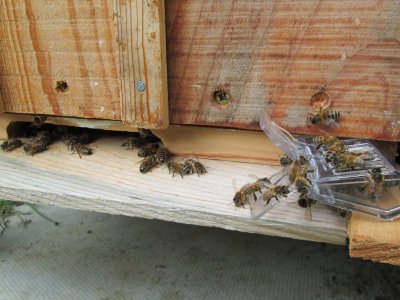
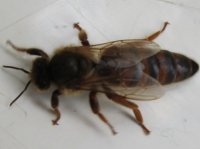
A swarm that had been discovered the previous day in a nearby town was run into a Warré box. The internal width of the box is the same as that of the ERB. The swarm in its Warré box was placed so that the ERB and Warré entrances were as close as possible and facing the same way.
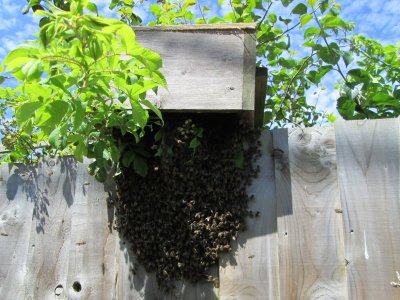
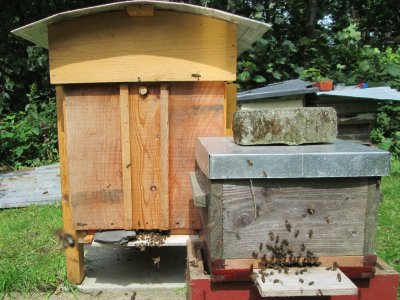
The same evening, which was rainy, the box, complete with its bees, was placed on wetted newspaper on the 8 frames of the ERB. The newspaper had small slits made in it with a pointed knife. The roof was re-fitted without the quilts, having placed an empty Warré box at the unused end of the ERB to keep the roof level.
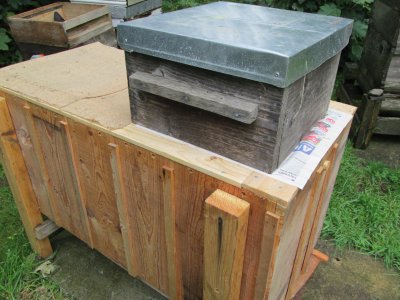
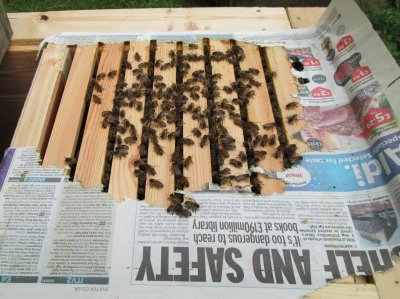
12 July 2015
A day after uniting some powdered newspaper was visible at the ERB entrance and many bees were orientating in front of the hive. There were no corpses. The setup was left for a further day. After removing the swarm's box it was immediately clear that uniting was successful and most of the newspaper was chewed away. The bees remaining in the swarm box were shaken and brushed into the ERB.
15 July 2015
A quick check on the colony showed a coherent nest. On several visits, a good supply of pollen was seen coming in.
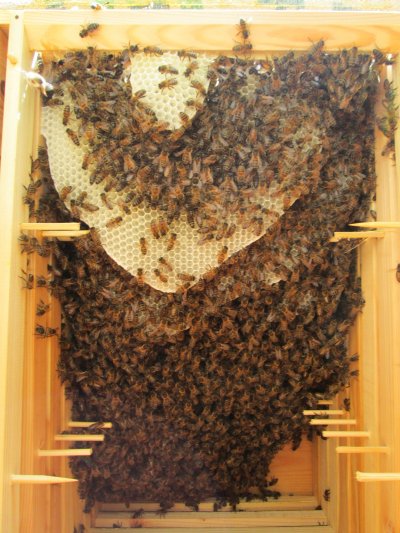
25 July 2015
The colony was checked for laying queen status. Capped worker brood (arrow below) and eggs were present indicating that the requeening with a swarm was successful.
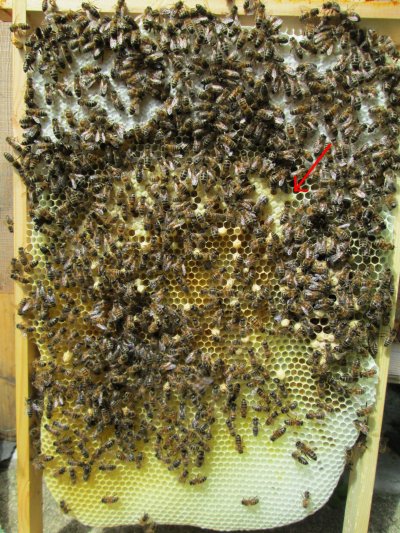
6 August 2015
Due to the drone layer queen of the original swarm, the colony had contracted considerably leaving outer new combs empty. In the photo below remnants of the newspaper used in uniting are visible on the hive floor.
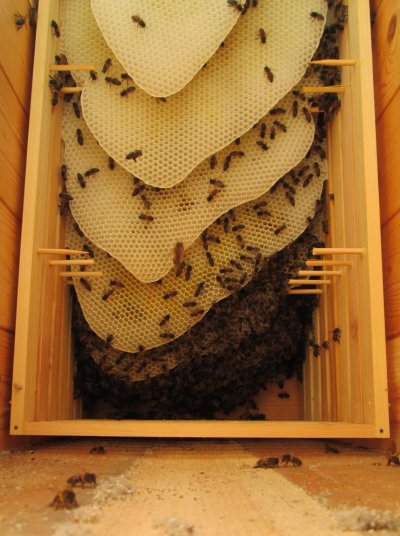
8 September 2015
Colony was inspected. No brood or eggs were visible. The queen, slimmed down to non-laying size, was on the front of frame 3. Several others of the author's hives were broodless during the nectar dearth of what proved to be a cool unmellifluous summer.
Stores were assessed by gauging capped honeycomb areas in each frame. About one frame of honey was present comprising 1140 cm2 honey. A Warré comb of 600 cm2 contains 1.5 kg honey at a conservative estimate. Therefore the stores were only 2.85 kg. As Warré colonies in this climate need 9 kg stores over winter it was decided that 6 kg feed should be given. During the following week, this was fed as 2:1 sugar:water in tubs at the back of the hive. The syrup was completely covered with wine bottle corks and sticks provided as a ladder.
22 October 2015
Ivy pollen coming in. Mouse guard fitted.
12 April 2016
Brood on frames 1-3 numbering from the entrance. F4 pollen frame. Plenty of stores left further in. Two part built frames were moved from the rear of the nest to the front to encourage brood to spread onto new comb.
14 May 2016
After unseasonally warm, sunny weather for a week the colony developed faster than expected. The cluster extended outside the rear follower board. After the bees had entered the main body of the nest they left behind a couple of combs that they had started (photos below).
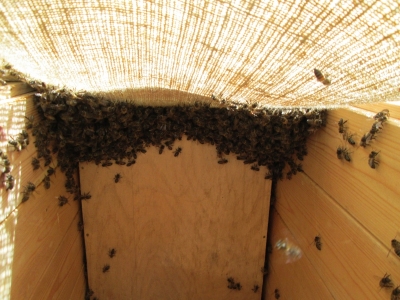
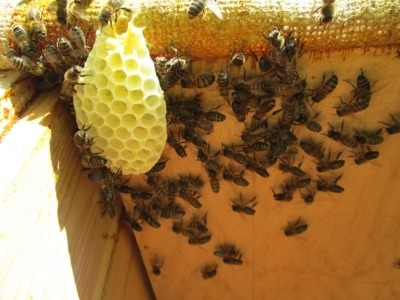
Three empty frames were added immediately to the rear of the nest (F14-16). The started combs were affixed to the comb guide of the frame nearest the nest using finger pressure.
23 May 2016
Already half of the rearmost frame given on 14 May was built and the two before it almost fully built. Gave two new frames. Many ventilator bees on the alighting board. Removed entrance block.
28 May 2016
A quarter of the rearmost frame given on 23 May was built. The next two were half and two thirds built respectively. Gave two more frames (F17, 18). Opened the top, front flight/ventilation hole.
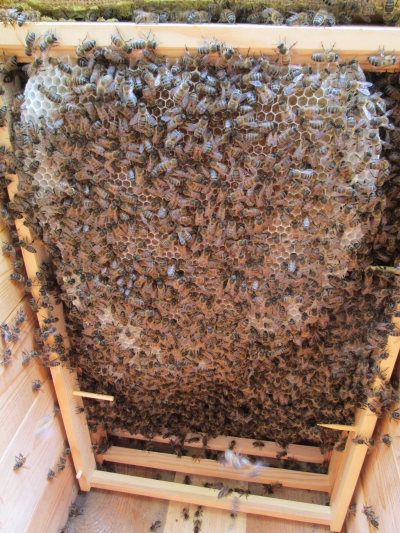
9 June 2016
The hive cavity behind the follower board was festooned with bees. They had chewed the top-bar cloth which was supported by a spare frame. They had built comb on this frame.
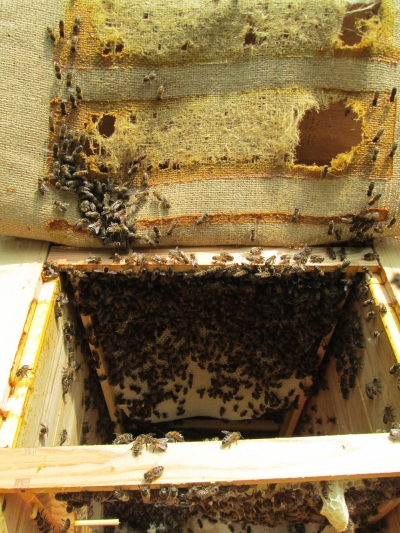
The comb against the follower board was fixed to it. In trying to free it, the comb dropped off the top-bar. It was propped at the back of the hive for the bees to empty.
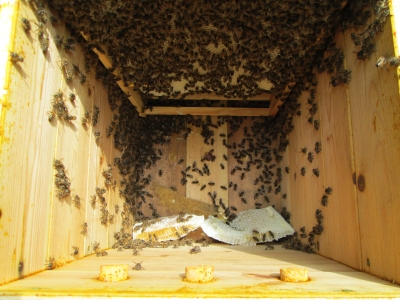
The next comb in from the fallen comb was curved, crossing at its middle into the previous frame.

Three more frames were installed (F19-21).
29 June 2016
Frame 22 added between F21 which had some comb started and F20.
3 July 2016
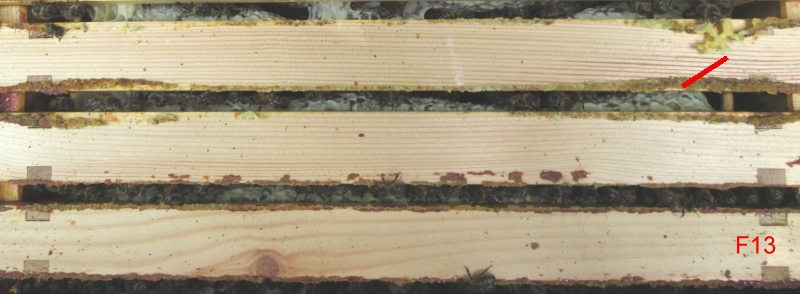
The rearmost comb surface of the brood nest is on the front side of frame 13. Almost all combs further to the rear are curved with the outer ends crossing to the adjacent frames away from the entrance. This makes moving individual frames very difficult and risks comb drop. Some correction of cross combing was possible with the hive tool but the rest was left until honey harvest time. There seems to be a considerable quantity of honey in frames 14-21.
In future, either more definitive comb guides are needed or the comb needs correcting as the colony expands and more frames are added. The photo below shows combs 21 & 20 (behind). In future, to ensure that the frames are filled with comb, additional frames will be supplied less rapidly.
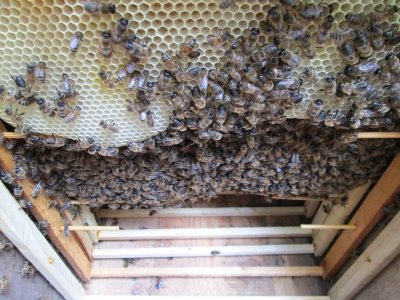
12 July 2016
Inspection prior to a planned apiary meeting that was cancelled: capped brood to the front of frame 2; larvae on the front of frame 3. The colony continued to have the most intense foraging traffic through the summer. The colony did not issue any swarms.
18 September 2016
The hive was opened for harvesting. F1 empty; F2 nectar; F3 pollen on rear surface; F4 & 5 capped brood & eggs; F6 & 7 capped brood & pollen; F8 pollen & nectar; F3-8 strips of honey at top ranging from a quarter to one eighth of a frame. Frames 1-11 were estimated to hold 2 full frames of honey. F12-14 heavy with honey were left in the hive to make up a total amount of honey adequate for wintering. F1 was moved to F12 position and a part built white comb moved to F1 position.
Seven frames (F15-21) with honey from the rear of the hive were taken for harvest in an ERB frame transport box. There was a considerable amount of crossed comb. Three frames had to be lifted out as a unit. Some comb fell off into the box. The hive yielded 8 kg honey. This more than pays for the frames and the hive.
For next season the plan is to put wax starter strips at the bottoms of the 'V' on the top-bars and use one or two straight frames from the brood nest to act as guides in the honey store.
2017
This hive survived the winter and continued to thrive through the spring and summer. It was inspected on 12 July. The first brood frame counting from the back was F7. There was a considerable amount of honey on frames to the rear of F7. On 16 July a meeting of Lleyn and Eifionydd Beekeepers Association took place in the apiary and this hive was demonstrated.
Below left: one of the rearmost frames. Below right: A brood frame (F8)
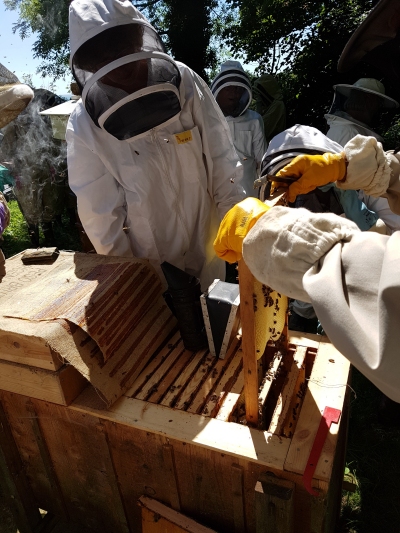
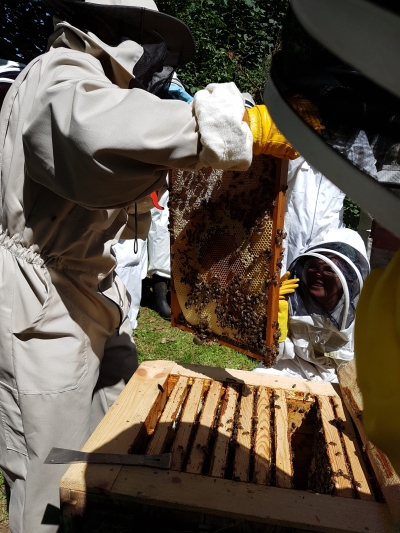
8 September 2017
A small new comb from near the back was moved to F1 position (front) and F1, nearly fully built, was moved to F11 position. Frames 2-11 contained altogether over 2.5 full frames of honey. The ten rearmost frames were taken to harvest. Most of it was suitable for cut comb honey but there is hardly any market for it in the locality. The capped honey was cut out into a food grade plastic box leaving as much as possible of the honey-free part of the comb intact. The comb was crushed with a potato masher, drained through a sieve and a jelly bag. The drained comb was pressed to extract the remaining honey. The yield was 10.9 kg (24 lb). The frames were returned to the hive, separated by a follower board from F11.
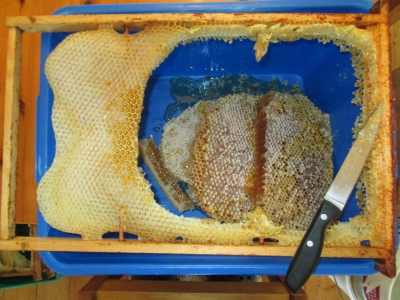
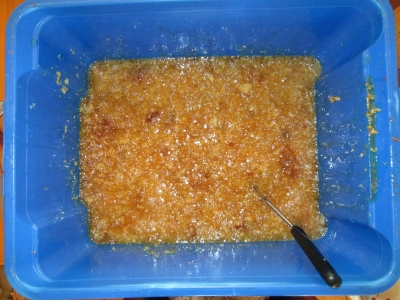
1 October 2018
Fitted mouse guard.
1 April 2018
The colony survived its third winter. Due to illness the follower board was lot moved to the back of the hive.
12 September 2018
After exceptionally good spring and summer weather all empty frames were filled with comb and honey and an unframed comb was built in the gap at the back of the hive. 12 rearmost frames of comb were harvested leaving more than enough honey in frames 1-9 for winter. Eggs were found on frame 6. The photo below left shows a typical honey comb weighing 4.1 kg with frame.
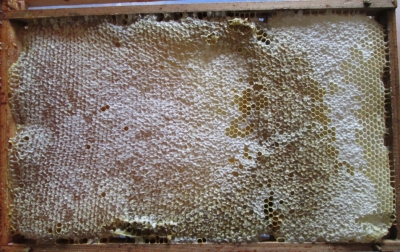
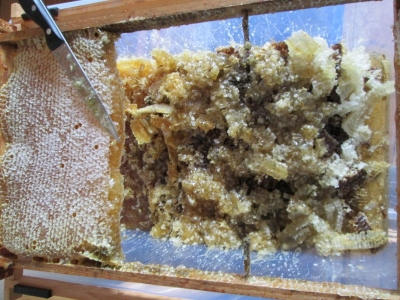
Comb and honey were extracted as shown above, this time into a clear polypropylene container. The honey was extremely dry, the driest showing 14.5% moisture on the refractometer. The dryness made it very viscous and the comb correspondingly difficult to crush. To facilitate crushing by two hands, a stainless steel potato masher was mounted on a wooden handle leaving sufficient clearance of the bottom of the handle from the crushed comb surface.

To see what extent separation of comb would occur by floatation, the crushed comb was left overnight. Although, some honey separated out by morning, the process was not far enough advanced to allow simply skimming off relatively dry comb.
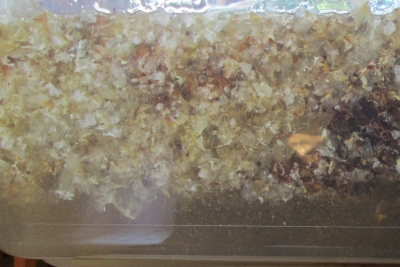
The comb was therefore again separated by straining. The crushed comb was difficult to handle as the honey was unusually dry. Some cells showed 14.5% moisture.
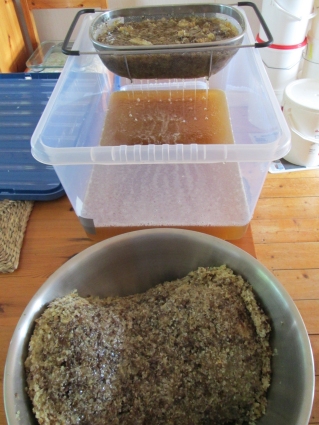
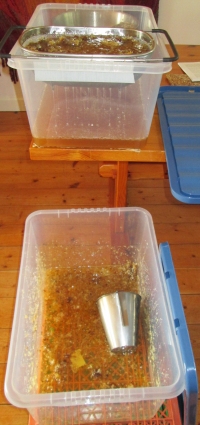
The yield was 37 kg (82 lb). The yields for 2016 and 2017 were 8 and 11 kg respectively. Thus the average yield is 18 kg per annum. This compares very favourably with published average yields for UK 'National' hives.
31 August 2019
Another good harvest of 13 frames.
1 September 2020
No brood or eggs. Queen failure in the colony's 6th season. Harvested all honey. Three brood combs frozen for two days and then stored in a bag.
20 June 2021
Inserted two old brood combs. The rest of the comb was white new comb left after cutting out the comb containing honey in September 2020. Repopulated by running-in a swarm of 0.95 kg. It was probably a 2-queen swarm, as one queen was found dead under the swarm catch basket before hiving and the swarm was behaving queen-right.
25 June 2021
Fed 1 kg sugar as 2:1 syrup in pot with floating corks and twigs as ladders. This feed was all taken by the following day. Pollen coming in.
2 July 2021
Brood on three sides of comb. As less than a kilo of bees was used to populate this hive, and there is much building of new comb to be done before winter, a swarm of 2.1 kg was united over newspaper with the colony. The incoming bees had all moved down onto the frames by 4 July and there was slight evidence of fighting in the form of dead bees in front of the entrance.
21 July 2021
Foraging vigorously; plenty of pollen coming in.
29 September 2021
As the weather had cooled down considerably and there for not ideal conditions for inspecting all the frames to assess winter stores, the decision was taken to give a precautionary feed. As a feed had been given after hiving the swarm and the ivy flow was in progress, the pre-winter feed was limited to 2 kg sugar as 2:1 syrup.
4 October 2021
Fitted mouse guard. Vigorous foraging on days of good weather. Plenty of ivy pollen coming in.
21 March 2022
Mouse guard removed. Colony survived winter.
10 April 2022
Some new comb building, colony expanding.
5 May 2022
Forager traffic looks weaker than other colonies in the apiary.
31 May 2020
Six combs of honey plus several half full. Brood nest appears constricted by honey and bee bread. Too few bees to make significant new comb though pollen seen coming in. Forager traffic diminished in recent weeks. Saw queen of frame 4 from entrance and patch of worker brood smaller than palm of hand. Eggs and larvae present in it. Patch of laid drone comb on frame 5. This colony was clearly not building up properly.
1 June 2022
Harvested six frames of honey yielding 13 kg extracted (16.2% moisture). One frame full of honey weighed 3.36 kg. Removed and killed the queen and shook out the bees on the ground. Arranged some part built and empty frames near the entrance. Shook in a prime swarm that had arrived at a nearby bait hive the day before. Confined the swarm to the front half of the hive using a division board with no bee spaces round the edges. A frame full of honey was left in the nest next to the follower board. Some of the original occupants tried to enter and there was some fighting, but eventually things settled down.
11 July 2022
Expanded the nest with empty frames, leaving the frame full of honey nearest to the follower board. Vigorous foraging noted since repopulation.
21 September 2022
Mouse guard fitted.
24 September 2022
Harvesting: due to comb crossing adjacent bars, a group of three part filled frames were harvested as a single unit plus one full comb that was not crossed. The group of three frames of comb contained many bees which were gradually expelled by smoking and brushing with a bird wing. Had harvesting been delayed until much cooler weather when the bees have gone into the winter cluster in the brood comb nearer the entrance, the harvested combs would be free of bees. The frames of harvested comb were transferred to a harvesting box. Sufficient combs of honey were left for wintering. The yield was 11.4 kg honey in comb or about 10.1 kg honey. So the total honey yield this season was 23 kg. Some of that was left from last season and not harvested until 1 June 2022. Honey from this and other trough hives in the apiary was noticeably drier (thicker) than honey from National or Warré hives. The trough hive honey averaged 16% moisture whereas the National/Warré showed just under 18%. The difference could possibly due to differences in humidity in the honey stores. Both the National and the Warré honey is harvested from above the cluster, whereas in the trough hives the honey stores are at the back of the nest away from the brood and most of the bees. Furthermore, the combs are arranged warm-way under top-bar cloths thereby being less accessible to convection of moist air from the nest.
Late September 2022
Colony very active foraging on ivy.
Notes
1. Fedor Lazutin (2013) Keeping Bees with a Smile -- A Vision and Practice of Natural Apiculture. Deep Snow Press, USA. www.horizontalhive.com www.deepsnowpress.com .
2. Matt Somerville, email: matt (at) workingwood (dot) net -- supplier of golden hive frames and modified golden hives
3. Warré, É. (1948) Beekeeping for All, p. 42. http://www.dheaf.plus.com/warrebeekeeping/preparing_hessian.htm
See Also
Matt Somerville's & John Haverson's modified golden hive, especially for the access to the bottom of the brood chamber.
Mellifera e.V. video on the ERB: https://www.youtube.com/watch?v=yFAEnQKkvlc
Opening an ERB (Michael Thiele): https://www.youtube.com/watch?v=BmYE7UxVuXI
A visit inside a straw ERB of Michel Thiele: https://www.youtube.com/watch?v=z1PBkfB5vCk
Klaus Hollmann's (Hamburg) ERB made by Fribin, Germany (in German): https://www.youtube.com/watch?v=Nnf9p9LV4eg
Other frame trough hive projects
David Heaf's modified Lazutin hive: http://www.dheaf.plus.com/framebeekeeping/oneboxhive.htm
Andrew Janiak's (Melbourne) trough hive: http://www.dheaf.plus.com/framebeekeeping/janiak_trough_hive.htm
Robin Dartington's 'long deep' (DLD) hive: http://tinyurl.com/pgrbcbs
The DLD hive adopted by Omlet as the 'Beehaus' https://www.omlet.co.uk/guide/bees/starting+out/the+beehive/ . Video: https://www.youtube.com/watch?v=0Xs_OVl25lw
Sweinty's trough hive with hinged roof: http://www.swienty.com/shop/vare.asp?side=0&vareid=101210
Bill Summers' trough hive project with concrete hives and plastic frames: http://thezesthive.com/
Swarm coming to Jonathan Powell's ERB format hive 'in the
spirit of' Fedor Lazutin's, i.e. double walled with insulation:
https://youtu.be/R5-H4DFjR9I .
Einraumbaute sellers
Mellifera e.V. (Germany): https://ssl.weitblick.net/service/mellifera-bienenkiste.2/blank.html
Janisch (Austria) http://www.bienen-janisch.at/index.php?route=common/page&id=958
Fribin (Germany) http://www.fribin.de/Einraumbeute.html
Frame trough hives in Poland, and the Slavic hive
Thanks to Konrad Szymanski for providing the following information:
Two types (3 historically) of frame trough hives:
Of those, the second one (300 x 435 mm ) is the most popular after the Wielkopolski hive with its frame 360 x 260mm. Nowadays many beekeepers are also using Langstroth 3/4, but a large part of small-scale beekeepers are still using Warsaw Extended hives. They are now most commonly used with one super with frames from the Wielkopolski hive 360 x 130 mm, or less commonly 300 x 130 mm.
The hive is well insulated, traditionally with straw, but now often
with styrofoam (expanded polystyrene), thought you still can buy them insulated with
straw, or even made from straw with just a wooden
frame. You can buy it with or without a super, on less or more frames (from 15 to even 25
frames).
It's often used with a cloth on the top-bars, but, more importantly, traditionally it is used with bars abutting one another, i.e. closing the spaces between combs. Later feeders, exluders, etc were added.
The biggest problem of this hive is the humidity while wintering,
there are cases of external combs going moldy.
Plans of Warsaw Extended with wielkoposki-frame super:
http://lovebee.pl/lovebee/wp-content/uploads/2013/12/ul-warszawski1.jpg
http://forum.pasiekaambrozja.pl/download/file.php?id=3028&mode=view
Warsaw Extended:
http://www.portalpszczelarski.pl/static/img/information/ab345fe9739cb522e6c87a2f6efd3623.jpg
http://www.portalpszczelarski.pl/static/img/information/669ba1f77ad87af6969f2ce3858cc5d2.jpg
http://www.portalpszczelarski.pl/static/img/information/183ab8c20c9b843241f059c012284624.jpg
http://www.portalpszczelarski.pl/static/img/information/32dcd1b8d5d66f1b46d92b9601e4f247.jpg
http://img19.staticclassifieds.com/images_tablicapl/308145063_2_1000x700_ule-warszawskie-poszerzane-naprawde-warto-zapraszam-do-zakupu-dodaj-zdjecia_rev001.jpg
http://img21.staticclassifieds.com/images_tablicapl/308145063_3_1000x700_ule-warszawskie-poszerzane-naprawde-warto-zapraszam-do-zakupu-pozostale-rolnicze_rev001.jpg
http://img20.staticclassifieds.com/images_tablicapl/308145063_1_1000x700_ule-warszawskie-poszerzane-naprawde-warto-zapraszam-do-zakupu-goldap_rev001.jpg
Comparision between frames Warsaw Extended and Wielkopolski:
http://pasiekawierzbie.pl/wp-content/uploads/2014/05/DSCN4168.jpg
Warsaw Normal old straw:
http://www.portalpszczelarski.pl/static/img/information/bf677c37a71b64b5c33bafb8d01263aa.jpg
http://www.portalpszczelarski.pl/static/img/information/c3f5069f79ec4e99c3845354ba4900b7.jpg
http://www.portalpszczelarski.pl/static/img/information/c5f2e06e2aabbb8a0d9db0f0237471de.jpg
Slavic:
http://img25.staticclassifieds.com/images_tablicapl/310499745_1_1000x700_sprzedam-ule-slowiany-debica.jpg
http://img27.staticclassifieds.com/images_tablicapl/310499745_6_1000x700_sprzedam-ule-slowiany-.jpg
http://img27.staticclassifieds.com/images_tablicapl/310499745_3_1000x700_sprzedam-ule-slowiany-pozostale-rolnicze.jpg
http://img26.staticclassifieds.com/images_tablicapl/310499745_5_1000x700_sprzedam-ule-slowiany-podkarpackie.jpg
http://img26.staticclassifieds.com/images_tablicapl/310499745_2_1000x700_sprzedam-ule-slowiany-dodaj-zdjecia.jpg
http://img27.staticclassifieds.com/images_tablicapl/310499745_4_1000x700_sprzedam-ule-slowiany-rolnictwo.jpg
David Heaf's home page: www.bee-friendly.co.uk .